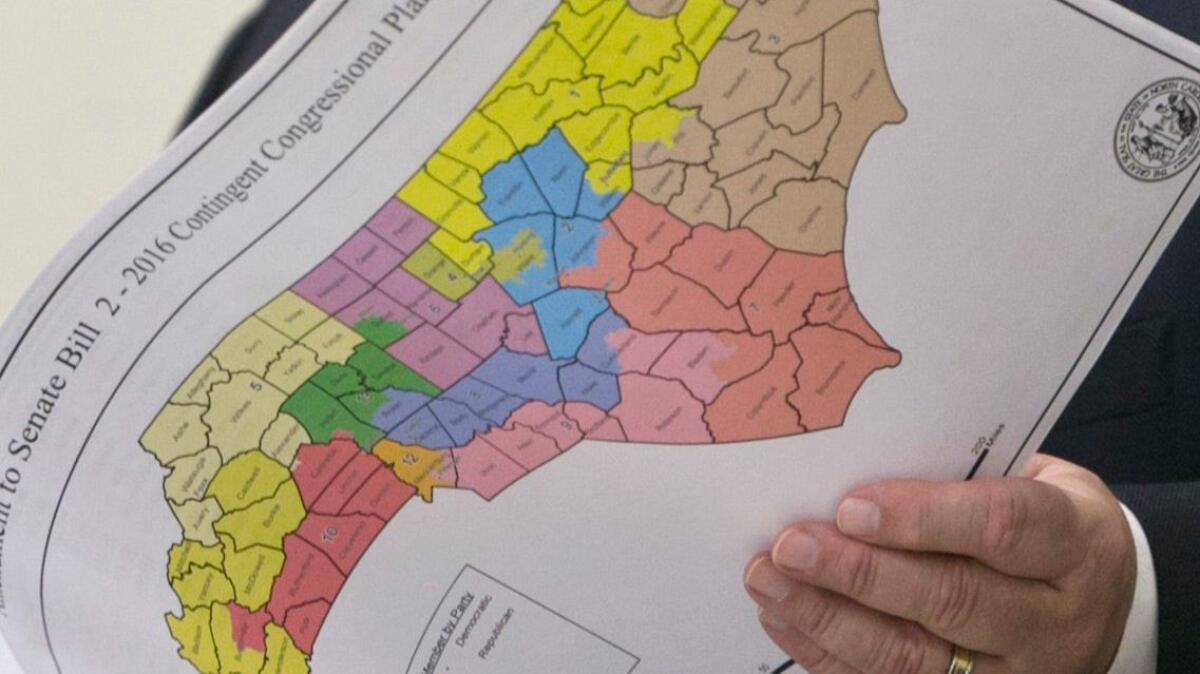Op-Ed: Can math stop partisan gerrymandering?

Of all the problems in our democracy, near the top of the list is partisan gerrymandering. Because legislators reserve for themselves the power to draw district boundaries, dozens of seats across America are uncompetitive and tens of millions of citizens are left with little influence over who represents them. This fall, the Supreme Court has an opportunity to remedy the offense â with the help of a little math.
Polarization is what makes partisan gerrymandering possible. As citizens sort themselves into neighborhoods of like-minded people, self-serving legislators can draw boundaries to artfully lasso them. Such jiggery-pokery creates districts where both parties have near-guaranteed wins. But thereâs an asymmetry: the party in control â which in most states is the GOP â distributes its supporters to win as many districts as possible by small but safe margins, while packing the rival partyâs voters tightly into far fewer districts.
In North Carolina, for example, the state Assembly and Senate have created a congressional map that reliably elects nine or 10 Republicans out of 13 seats. These seats are secure even when Democrats win the statewide popular vote, as they did in 2012.
Gerrymandering in North Carolina
Although some argue that partisan unfairness arises naturally because Democrats tend to cluster in urban areas, this is not the whole story. After the 2010 wave election and 2012 redistricting, GOP gerrymandering more than doubled the effects of clustering, flipping seats far faster than population migration could possibly explain. Of course, Democrats played the game, too, and in total, more than 70 seats were made uncompetitive for one side or the other. Republicans, however, ended up with a net gain of 16 or 17 safe seats, a difference that can almost exactly account for why they retained control of the House in 2012 despite losing the national popular vote. Without gerrymandering, their 2016 majority would be approximately 231 to 200 seats, a 31-seat margin that is substantially smaller than their current margin of 45 seats. (That might have made all the difference in Thursdayâs American Health Care Act vote.)
Number of U.S. House seats gained by partisan gerrymandering, 1972-2016 (averaged by redistricting cycle)
Others shrug off the gerrymandering problem since âboth sides do itâ or because it seems too difficult to establish what a fair outcome might look like. In fact, however, researchers can use a Monte Carlo analysis to do exactly that.
A centuries-old technique, the Monte Carlo works a bit like building a fantasy sports team. Letâs imagine that voters in State X break 55% Democratic and 45% Republican, which results in a congressional delegation of three Democrats and six Republicans. Researchers can then instruct a computer to randomly pick combinations of districts from around the United States that yield the same partisan voter breakdown â 55 to 45 â and compare the fantasy delegation results to the actual result. The fantasy average â in this case five Democrats and four Republicans â reveals how a delegation would be constituted if its districts were drawn according to prevailing national standards, and not contorted to protect a party or an incumbent.
Some of Americaâs most gerrymandered districts
In North Carolina, where the House vote in 2016 was 47% Democratic and 53% Republican, the average simulated delegation had eight Republicans. The actual outcome of 10 Republicans occurred in less than 4% of simulations. Since North Carolina Republicans controlled redistricting, we can say with confidence that their creative efforts helped them gain two seats more than what typical districting practices would have produced.
Courts may provide the best route for reform. And this fall, as luck would have it, two partisan gerrymandering cases out of North Carolina and Wisconsin give the Supreme Court a chance to lay down some ground rules.
Setting aside the Monte Carlo analysis, the most straightforward way to determine if gerrymandering has gone too far is to ask whether one sideâs wins were exceptionally lopsided compared with the other. In North Carolina in 2016, for example, Democrats won their three seats by an average margin of 37 points, while Republicans won by only 21 points. Using what may be the worldâs most widely-used statistical test, the ât-test,â such an outcome would only occur by chance 1 out of 350 times. Courts would still have to decide where to draw the line â 1 out of 350 may be ridiculous, but whatâs acceptable? Since scientists consider 1 out of 20 âstatistically significant,â perhaps thatâs the most logical threshold.
More complex measures of extreme gerrymandering are possible too, such as the efficiency gap, which political scientists have devised to estimate how many votes have been âwasted.â
A statistical standard could certainly harmonize with existing election law, which already requires that districts have equal populations, but allows odd shapes to accommodate minority voting rights. Because of their ubiquity in the sciences, the t-test or efficiency gap are likely to withstand detailed critiques in a court challenge.
Five justices, including Associate Justice Anthony M. Kennedy, have expressed interest in establishing a standard such as the ones we have described. If Kennedy were to finally rein in gerrymandering, that would cap an already-distinguished legacy of his nearly 30 years on the Supreme Court.
Sam Wang is professor of neuroscience at Princeton University. He and Brian Remlinger, a statistical research specialist, run the Princeton Gerrymandering Project.
Follow the Opinion section on Twitter @latimesopinion or Facebook.
More to Read
A cure for the common opinion
Get thought-provoking perspectives with our weekly newsletter.
You may occasionally receive promotional content from the Los Angeles Times.










